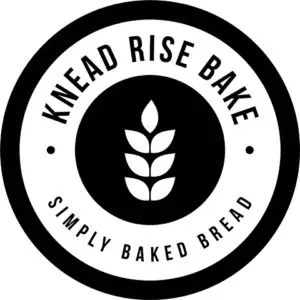One of the things that makes bread so interesting, is the wide range of flavors and textures that can be created with a few basic ingredients. And bagels are one of the more unique versions of bread, as the texture of a bagel isn’t quite matched by any other variety of bread aside from its close cousin the pretzel.
But what makes them different? Where does their trademark chewy texture come from?
Bagels are chewier and denser than traditional bread because they are made from high protein flour and are boiled for 30-60 seconds per side before they are baked. Boiling bagel dough before baking ensures the crumb will be chewy because the starch on the outside of the dough gelatinizes and sets which keeps the dough from rising during baking. Using high protein flour also ensures a chewier texture by increasing the gluten (chew) content.
But, there is a lot more going on in there that needs to be unpacked. Let’s dive in.
What Does the Boil Do for the Final Texture?
Boiling bagels does a couple of things to ensure that the trademark bagel chew is achieved.
- Boiling Partially Sets the Crust Before Baking
Boiling bagel dough causes the perimeter of the dough to gelatinize which forms a softshell crust that still allows the bagel to steam off during baking while rising slightly. The soft aspect is important as a hard crust wouldn’t allow for steaming or rising which would result in a very dense and gummy bagel. Conversely, if the crust was too soft it would rise and become quite fluffy and resemble the texture of a dinner roll. The gelatinized surface is what really helps achieve the perfect bagel crumb. Kind of Goldilocks and the bears’ beds. Not too hard and not too soft. - Boiling Gives the Bagel Crust a Tough But Soft Finished Texture
The crust is probably one of the most distinguishable aspects of a bagel, and might likely be the one aspect that actually makes a bagel a bagel. The trademark crust adds to the chewy texture of the overall bite of a bagel. The gelatinized crust creates a soft but stiff bite that almost resists tearing as you chew. Unlike the crust of a dinner roll that tears and dissolves quickly as you chew.
The longer a bagel boils, the tougher the crust will become when baked. So it’s important to keep the boil time fairly short in order to achieve that trademark bagel chew. 30-60 seconds per side is all the boiling needed. And sticking close to 30 seconds is what we like most.
When done right, there isn’t quite anything like a bagel, and likely why they are so widely popular.
How Much Protein is Enough to Create Chewy Bagels?
When it comes to protein content in flour, it is measured in percentages and each class of flour falls into a certain percentage range. High protein flour would be anything at or around 13-14 percent protein, and the types of flour that fall into that category are usually labeled High Gluten Flour (link takes you to Amazon).
If all you have access to is all-purpose or bread flour and you want to experiment a bit with your bagel chewiness, you could crank up the protein in any flour by adding Vital Wheat Gluten (link takes you to Amazon).
The purpose of the higher protein is to increase the amount of gluten that will be present in your dough once it’s ready to bake. Protein in flour is what turns into gluten once water is mixed in. Kneading and rising helps to build and strengthen gluten, but the only way to increase the gluten in dough is to increase the protein count.
But what is so great about gluten for bagels? Gluten is what gives dough its elasticity, and thus makes bread chewy instead of crumbly. This is why, on the opposite end of the spectrum, biscuits are made with low protein flours to maximize their flaky crumbly texture. But, be careful not to think that more protein is always better. Too much protein will cause an incredibly dense and rubbery bread. Once you get above about 15 percent protein content, bread can get really gummy. So, if you do opt to grab some vital wheat gluten, be modest with the amount used until you find the right mixture for you.
There are a plethora of recipes out there that walk you through the process of using a good balance of bread flour ramped up with vital wheat gluten, like this one: https://cosetteskitchen.com/recipe/bagels.
If you’ve attempted to bake bagels with all-purpose or bread flour, and found them a little lacking, it might be due to the protein content. This is especially if your bread flour or all-purpose flour is on the low end of the protein range. Ramp up the protein/gluten and see what happens.
Stiff Dough Also Plays a Significant Role in the Finished Texture
The two most important elements for a nice chewy bagel are certainly high gluten content and boiling before baking, but a stiff dough is important as well. Bagel dough, depending on the recipe you are using, is probably one of the stiffest doughs in the baking world.
This is primarily important because bagel dough needs to stand up to the boiling stage. But beyond that, bagel dough is just heavily handled all the way through the baking process. The final shape takes quite a bit of handling which is followed by more handling to get them in and out of their boiling bath, and then blasted by the high temperatures in the oven.
But beyond standing up to the abuse, the stiff dough itself also accounts for some of the density of the finished bagel. And the density adds to the chew. So when you’re looking at recipes, stick to recipes with a dough that tends to stay on the stiffer side. Which generally speaking means it will use less liquid ingredients.
Related Questions:
Many recipes call for malt syrup to be added to the water, does that add to the chew?
No, malt syrup is mostly added for flavor and browning. You could leave the malt out and give the bagels a milk or egg wash before baking and it would provide similar browning to occur, but it would be lacking the tangy sweetness that bagels often have.
What makes the tops so smooth?
It’s actually fairly hard to make homemade bagels smooth on top. What I’ve experienced in my bagel adventures to help with smooth bagels is three key things.
Kneading:
Knead and knead some more. If you have a stand mixer (our budget pick and old faithful: links take you to Amazon) absolutely use it! Having very strong gluten content is important for standing up to boiling water. Without strong gluten content, the dough will dimple in the boiling water.
Rolling Dough:
Rolling the dough into rings is superior to puncturing a hole in the center and stretching. I’m sure there is an industrial way to make the second option work, but in my experience doing it at home creates a weak surface that dimples during boiling. Rolling tends to cause less dimpling and has a more overall uniform look.
Rolling the dough looks something like this…
Lowering Boiling Temperature:
Lowering your water temperature so that it is not a harsh boil is ideal, try getting your water to “just before boil” temperatures. Less action in the water helps for the bagel’s surface to stay smooth while it sets.
But again, it’s very hard to do and takes quite a bit of effort and practice to achieve.

